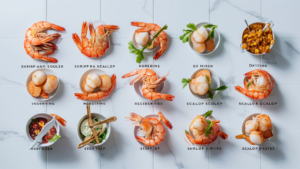If you’re a seafood lover, you know that shrimp and scallops are two of the most versatile and delicious ingredients you can cook with. From quick weeknight dinners to elegant dishes for entertaining, shrimp and scallop recipes offer endless possibilities for creating mouthwatering meals. Whether you prefer them seared, grilled, or cooked in a rich sauce, these recipes will help you bring restaurant-quality seafood to your home kitchen.
Why Choose Shrimp and Scallops?
A Delicious and Nutritious Protein
Shrimp and scallops are not only delicious but also packed with lean protein, making them a healthy option for any meal. Shrimp is low in calories and high in essential nutrients like selenium, vitamin B12, and omega-3 fatty acids. Scallops, on the other hand, are rich in vitamins and minerals such as magnesium, potassium, and phosphorus, which contribute to heart health and muscle function. Together, they create a nutritious and flavorful foundation for a variety of dishes.
Quick and Easy to Prepare
One of the greatest advantages of cooking with shrimp and scallops is their quick cooking time. Both shrimp and scallops cook in just a few minutes, making them ideal for fast weeknight dinners or last-minute entertaining. With just a little prep work, you can have a delicious seafood dish on the table in under 30 minutes. Their mild flavor pairs well with a variety of seasonings, sauces, and sides, allowing you to get creative in the kitchen.
Essential Ingredients for Shrimp and Scallop Recipes
To make the best shrimp and scallop recipes, you’ll need a few key ingredients. Here’s what you’ll typically use:
- Shrimp: Opt for large or jumbo shrimp for the best texture and flavor. They should be peeled, deveined, and with tails removed. Fresh shrimp work best, but frozen shrimp that have been properly thawed will also work well.
- Scallops: Sea scallops are preferred for most recipes due to their larger size and tender texture. Look for scallops that are firm and smell fresh, with a slightly sweet aroma.
- Butter and Olive Oil: Butter and olive oil are essential for cooking shrimp and scallops, as they help achieve that perfect sear while adding richness to the dish.
- Garlic: Garlic adds a fragrant, savory flavor that complements the sweetness of shrimp and scallops. Fresh garlic is preferred, but garlic powder can be used in a pinch.
- Lemon: A squeeze of fresh lemon juice brightens up seafood dishes and adds a refreshing acidity that balances the richness of butter and oil.
- White Wine: White wine is often used to deglaze the pan and create a light, flavorful sauce for shrimp and scallop dishes.
- Fresh Herbs: Herbs like parsley, basil, or thyme add color and freshness to seafood recipes, enhancing both the flavor and presentation.
- Pasta or Rice: Shrimp and scallops pair beautifully with pasta or rice, making them an ideal addition to dishes like risotto, linguine, or pilaf.
Optional Ingredients and Flavor Boosters
- Crushed Red Pepper: For a little heat, sprinkle crushed red pepper flakes into your shrimp and scallop dishes.
- Parmesan Cheese: A sprinkle of Parmesan cheese adds a savory, umami flavor that pairs perfectly with creamy sauces and pasta dishes.
- Shallots: Shallots provide a milder, sweeter onion flavor that complements the delicate taste of seafood.
- Tomatoes: Fresh or sun-dried tomatoes add a burst of acidity and color to shrimp and scallop recipes, enhancing both flavor and appearance.
Step-by-Step Shrimp and Scallop Recipe: Garlic Butter Shrimp and Scallops
Ingredients
- 1 lb large shrimp, peeled and deveined
- 1 lb sea scallops, patted dry
- 4 tablespoons unsalted butter
- 2 tablespoons olive oil
- 4 cloves garlic, minced
- 1/4 cup white wine (optional)
- Juice of 1 lemon
- Salt and pepper to taste
- 2 tablespoons fresh parsley, chopped
- Lemon wedges for serving
Instructions
Step 1: Prepare the Shrimp and Scallops
- Pat the shrimp and scallops dry with paper towels to remove any excess moisture. This step is crucial for achieving a good sear.
- Season both the shrimp and scallops with salt and pepper on both sides.
Step 2: Sear the Scallops
- In a large skillet, heat 2 tablespoons of olive oil over medium-high heat until hot.
- Add the scallops to the skillet, making sure not to overcrowd the pan. Sear the scallops for about 2-3 minutes per side, or until they develop a golden-brown crust. Avoid moving the scallops too much as they cook to ensure a good sear.
- Once the scallops are cooked, remove them from the skillet and set them aside on a plate.
Step 3: Cook the Shrimp
- In the same skillet, add 2 tablespoons of butter and allow it to melt.
- Add the minced garlic and cook for about 30 seconds, until fragrant.
- Add the shrimp to the skillet and cook for about 2 minutes per side, or until they turn pink and opaque.
- If using white wine, pour it into the skillet to deglaze the pan, scraping up any browned bits from the bottom. Let the wine simmer for 1-2 minutes until slightly reduced.
Step 4: Combine and Serve
- Return the scallops to the skillet with the shrimp.
- Squeeze the juice of one lemon over the seafood and toss to coat everything in the garlic butter sauce.
- Garnish with fresh parsley and serve with lemon wedges on the side.
- Serve the shrimp and scallops over pasta, rice, or alongside a fresh salad for a complete meal.
Tips for Perfect Shrimp and Scallops

Pat the Seafood Dry
One of the most important tips for cooking shrimp and scallops is to ensure that they are dry before cooking. Excess moisture will prevent them from searing properly, resulting in a less flavorful dish. Pat them dry with paper towels and make sure your pan is hot before adding them.
Don’t Overcook the Seafood
Shrimp and scallops cook very quickly, so it’s important not to overcook them. Overcooked shrimp become tough and rubbery, while overcooked scallops can turn chewy. Cook shrimp until they are pink and opaque, and scallops until they are golden-brown on the outside but still tender on the inside.
Use Fresh Ingredients
For the best flavor, use fresh ingredients whenever possible. Fresh garlic, lemon juice, and herbs will enhance the overall taste of your dish. Additionally, using high-quality butter and olive oil can make a big difference in the richness and depth of flavor.
Experiment with Flavors
Shrimp and scallops are versatile and can be paired with a wide variety of flavors. Don’t be afraid to experiment with different herbs, spices, and sauces to create your own unique seafood dishes. Whether you prefer a classic garlic butter sauce or want to try something new like a spicy Cajun seasoning, the possibilities are endless.
Variations on Shrimp and Scallop Recipes
Creamy Shrimp and Scallop Pasta
For a rich and indulgent twist on classic shrimp and scallop recipes, try making a creamy pasta dish. Cook the shrimp and scallops as directed, then remove them from the skillet. In the same pan, add heavy cream, Parmesan cheese, and a pinch of nutmeg to create a creamy sauce. Toss the cooked pasta in the sauce and top with the shrimp and scallops for a decadent meal.
Grilled Shrimp and Scallop Skewers
For a lighter option, try grilling shrimp and scallops on skewers. Marinate the seafood in olive oil, lemon juice, garlic, and fresh herbs, then thread them onto skewers. Grill over medium-high heat for 2-3 minutes per side, or until the shrimp and scallops are cooked through. Serve with a fresh salad or grilled vegetables for a healthy and flavorful meal.
Shrimp and Scallop Risotto
If you’re in the mood for comfort food, shrimp and scallop risotto is a great choice. Start by cooking Arborio rice in chicken or seafood broth until it becomes creamy and tender. In a separate pan, cook the shrimp and scallops as directed. Stir the cooked seafood into the risotto and finish with a sprinkle of Parmesan cheese and fresh herbs.
Spicy Cajun Shrimp and Scallops
For a bold and flavorful dish, try making Cajun-style shrimp and scallops. Season the seafood with Cajun seasoning, paprika, and a touch of cayenne pepper for heat. Sear the shrimp and scallops in a hot skillet, then serve over rice or grits for a Southern-inspired meal.
Serving Suggestions for Shrimp and Scallop Recipes
Pair with Pasta or Rice
Shrimp and scallops are delicious when paired with pasta or rice. Whether you prefer a simple linguine or a creamy risotto, these grains provide a satisfying base for your seafood dishes. Additionally, you can add fresh vegetables like spinach, cherry tomatoes, or asparagus to create a more balanced meal.
Add Fresh Vegetables
For a lighter option, serve your shrimp and scallops with fresh vegetables. A crisp green salad, roasted Brussels sprouts, or sautéed spinach can add color and nutrition to your plate. Additionally, the fresh flavors of the vegetables will help balance the richness of the seafood.
Serve with Crusty Bread
Crusty bread is the perfect accompaniment to seafood dishes with a flavorful sauce. Whether you’re serving shrimp and scallops in a garlic butter sauce or a creamy pasta, a slice of toasted baguette or ciabatta will help soak up every last drop of sauce.
FAQs About Shrimp and Scallop Recipes
Can I Use Frozen Shrimp and Scallops?
Yes, you can use frozen shrimp and scallops in your recipes. However, it’s important to thaw them properly before cooking. Place the frozen seafood in the refrigerator overnight or run them under cold water until thawed. Be sure to pat them dry with paper towels to remove any excess moisture before cooking.
How Do I Store Leftover Shrimp and Scallops?
Leftover shrimp and scallops can be stored in an airtight container in the refrigerator for up to two days. To reheat, gently warm them in a skillet over low heat to prevent overcooking. Avoid microwaving the seafood, as it can cause it to become rubbery.
Can I Substitute Bay Scallops for Sea Scallops?
Yes, you can substitute bay scallops for sea scallops in most recipes. However, bay scallops are smaller and more delicate, so they cook faster than sea scallops. Be sure to adjust the cooking time accordingly to avoid overcooking.
Is It Necessary to Remove the Muscle from Scallops?
Yes, it’s a good idea to remove the small, tough muscle attached to the side of the scallop before cooking. This muscle can become chewy when cooked, so it’s best to gently pull it off with your fingers before searing the scallops.
What’s the Best Way to Reheat Shrimp and Scallops?
The best way to reheat shrimp and scallops is to gently warm them in a skillet over low heat. This helps prevent them from overcooking and becoming rubbery. You can also add a little butter or sauce to the pan to keep the seafood moist as it reheats.
Conclusion: Enjoying Your Shrimp and Scallop Recipes
Shrimp and scallop recipes offer a delicious and versatile way to enjoy seafood at home. Whether you’re making a simple garlic butter dish or a more elaborate creamy pasta, these recipes are sure to impress. With the right ingredients and techniques, you can create restaurant-quality seafood dishes in the comfort of your own kitchen. So, gather your ingredients, follow the steps outlined in this guide, and enjoy the rich, flavorful taste of shrimp and scallops at your next meal.
Bon appétit!

